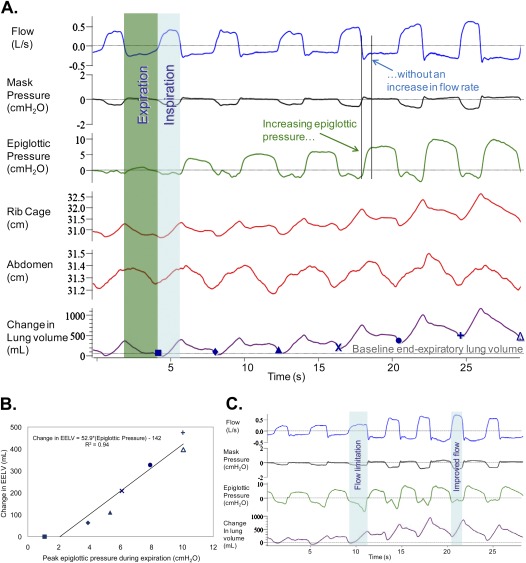A 37-year-old man with severe obstructive sleep apnea presented to our sleep disorders research laboratory and was instrumented with an epiglottic catheter, pneumotachograph, and magnetometers (to measure relative changes in lung volume) as part of an ongoing study.
During the night there were periods of spontaneous, sustained increases in upper airway resistance during expiration (Figure 1A). During these periods, expiratory positive airway pressure developed at the level of the epiglottis (epiglottic pressure channel). Note that although epiglottic pressure increases during expiration, there is no corresponding increase in flow or mask pressure, suggesting a choke point between the epiglottis and airway opening. Expiratory positive airway pressure was associated with an increase in end-expiratory lung volume (rib cage, abdomen, and change in lung volume channels) according to the total respiratory system compliance (Figure 1B). Although other factors may be important, such as upper airway muscle activation, the increase in end-expiratory lung volume was generally associated with a decrease in upper airway resistance (increased flow despite less negative epiglottic pressure) (Figure 1C).
Figure 1.
Nasal expiratory resistance valves may improve obstructive sleep apnea in a subset of patients, but the mechanism of action is not known (1, 2). Expiratory resistance valves increase end-expiratory lung volume during wakefulness, which might stabilize the upper airway, but this phenomenon has not been clearly demonstrated during sleep.
This spontaneously occurring example provides proof of concept that expiratory resistance acts to increase end-expiratory lung volume during sleep via generation of expiratory positive airway pressure. Furthermore, it suggests that such increased end-expiratory lung volume can stabilize the upper airway during inspiration.
This image has not been previously published in any form.
Supplementary Material
Footnotes
Author disclosures are available with the text of this article at www.atsjournals.org.
References
- 1.Berry RB, Kryger MH, Massie CA. A novel nasal expiratory positive airway pressure (EPAP) device for the treatment of obstructive sleep apnea: a randomized controlled trial. Sleep 2011;34:479–485 [DOI] [PMC free article] [PubMed] [Google Scholar]
- 2.Patel AV, Hwang D, Masdeu MJ, Chen GM, Rapoport DM, Ayappa I. Predictors of response to a nasal expiratory resistor device and its potential mechanisms of action for treatment of obstructive sleep apnea. J Clin Sleep Med 2011;7:13–22 [PMC free article] [PubMed] [Google Scholar]
Associated Data
This section collects any data citations, data availability statements, or supplementary materials included in this article.



